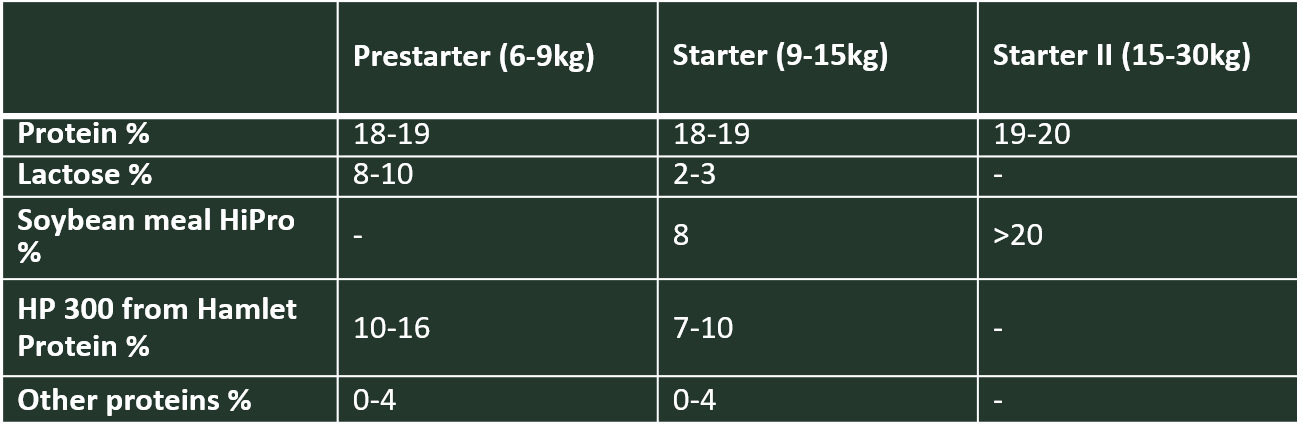An all-soy piglet diet is the cost-effective choice
Reducing the challenges to piglet digestion is the foundation for lifelong healthy growth
By Jes Klausen, Nutritionist, Hamlet Protein
Every nutritionist’s goal is to develop the best possible diets to carry pigs smoothly through life and ensure the very best performance within the confines of the chosen raw materials and additives. The priority, of course, is to develop a feed strategy that will get pigs to market as fast as possible and result in the optimum profits for the farmer.
So, how do you do that? And what special considerations are required at each stage of a pig’s life?
In essence, it’s about distinguishing between the needs of a young piglet with an immature gut and a pig from around 15kg where the gut has reached maturity and produces enough digestive enzymes to break down soybean meal and grain without any problem.
It’s during the first weeks of a pig’s life that the foundations for healthy growth are laid. Raw materials must be chosen carefully to ensure an easy transition between stages without disturbing the gut microflora, gut wall and digestion overall.
During the growth period up to 15kg, piglets generally need at least two, specially formulated feed types – a prestarter from 6kg to 9kg and a starter from 9kg and up. If piglets weigh less than 6kg at weaning, a special creep feed is also necessary.
Four key factors to consider
- Clean raw materials - Healthy piglets rely on a feed that is highly digestible and low in anti-nutritional factors (ANFs). If feed protein is hard to digest and absorb, more additives will be necessary to counter the negative effect.
- Additives - A highly digestible feed typically contains fewer additives. However, additives may be necessary to solve specific on-farm issues, such as low health status.
- Nutrient standards - Nutritionists work with a set of norms for pig feed at each phase of production. These are set by organizations such as NCR, CVB, SEGES and INRA.
- Restrictions on antibiotics and zinc oxide - In countries that restrict the use of antibiotics and zinc oxide, the choice of raw materials is even more critical to keep issues like post-weaning diarrhea under control. This has led to the
common practice of reducing crude protein and adding more additives. However, this is a strategy that is likely to impair performance and increase feed costs.
A new feeding strategy
Because even high-quality proteins like fishmeal contain ANFs, many formulators have chosen to overcome inclusion limits by mixing a range of protein sources in prestarter and starter feed. The drawback for piglet performance is the combination of ANFs and the change in gut microbiota that occurs in every feeding phase.
This is why the case for choosing an exclusively soy strategy is strong. At Hamlet Protein, special processing technology maximizes the digestibility of soy protein and reduces the ANF content to a minimum. It means that piglet guts are no longer challenged by multiple protein sources, easing the transition up to 15kg.
The benefits:
- Highly digestible protein is easily absorbed, reducing the risk of diarrhea
- Inert fibers maintain the intestinal flow in the first critical days after weaning
- Fermentable fibers support gut microflora development from 3 to 5 days of age
- Low ANF levels minimize inflammation, trypsin inhibitors, non-protein nitrogen and oligosaccharides
- High water-binding capacity helps establish a balanced pH in the stomach

Feeding table for a soy only strategy with highly digestible, low-ANF soy protein.
A soy only feed is a reliable choice for fast and healthy piglet growth. High digestibility and a low ANF content allows for limitless inclusion in piglet feed. From our experience, there is only one outcome – better performance and a solid bottom line.
Events with Hamlet Protein
We attend events around the world. Meet us at exhibitions and seminars - we always look forward to welcoming you!
We also sponsor conferences with focus on young animal nutrition.
Have a look below where to meet us next.


